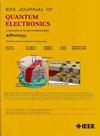垂直光束输出平面红外激光腔的二维光子晶体
IF 2.2
3区 工程技术
Q3 ENGINEERING, ELECTRICAL & ELECTRONIC
引用次数: 0
摘要
建立了一种半解析三维模型来描述在半导体激光波导异质结构中形成的无限二维光子晶体的模态结构。在提出的仿真模型框架内,研究了激光模式光通过表面输出的效率与光子晶体几何特性之间的关系。作为一个例子,我们对基于AlGaAs/InGaAs材料体系的波导异质结构的光输出损耗进行了计算和分析。该研究的重点是具有简单几何形状的方形对称光子晶体,包括圆形和三角形。结果表明,利用圆孔光子晶体设计平面结构的表面发射激光器具有较低的辐射输出效率。采用填充系数大于0.1-0.2的三角形孔形状可以实现高效的光输出,而三角形孔的对称性对输出效率有显著影响。填充系数还决定了模式判别和单模或多模操作的条件。包含规则三角形光子晶体的结构显示出最高的输出损耗,而增强平面波导和光子晶体之间的模式重叠导致输出损耗从2增加到10 cm ${}^{\ mathm{-1}}$。本文章由计算机程序翻译,如有差异,请以英文原文为准。
Two-Dimensional Photonic Crystals for Planar IR Laser Cavities With Vertical Beam Output
A semi-analytical 3D model has been developed to describe the modal structures of an infinite two-dimensional photonic crystal formed in a semiconductor laser waveguide heterostructure. Within the framework of the proposed simulation model, the relationship between the efficiency of laser mode light output through the surface and the geometric characteristics of the photonic crystal has been studied. As an example, we performed calculations and analysis of optical output losses in a waveguide heterostructure based on the AlGaAs/InGaAs material system. The study focused on square symmetry photonic crystals with simple geometric shapes, including circles and triangles. The results demonstrate that surface-emitting lasers designed in planar structures using photonic crystals based on circular holes have low radiation output efficiency. Efficient light output can be achieved by using triangular hole shapes with a fill factor greater than 0.1-0.2, while the symmetry of the triangular hole significantly influences the output efficiency. The fill factor also determines the mode discrimination and the conditions for single-mode or multi-mode operation. Structures incorporating regular triangular photonic crystals exhibit the highest output losses, while enhancing the mode overlap between the planar waveguide and the photonic crystal leads to an increase in output losses from 2 to 10 cm ${}^{\mathrm {-1}}$ .
求助全文
通过发布文献求助,成功后即可免费获取论文全文。
去求助
来源期刊

IEEE Journal of Quantum Electronics
工程技术-工程:电子与电气
CiteScore
4.70
自引率
4.00%
发文量
99
审稿时长
3.0 months
期刊介绍:
The IEEE Journal of Quantum Electronics is dedicated to the publication of manuscripts reporting novel experimental or theoretical results in the broad field of the science and technology of quantum electronics. The Journal comprises original contributions, both regular papers and letters, describing significant advances in the understanding of quantum electronics phenomena or the demonstration of new devices, systems, or applications. Manuscripts reporting new developments in systems and applications must emphasize quantum electronics principles or devices. The scope of JQE encompasses the generation, propagation, detection, and application of coherent electromagnetic radiation having wavelengths below one millimeter (i.e., in the submillimeter, infrared, visible, ultraviolet, etc., regions). Whether the focus of a manuscript is a quantum-electronic device or phenomenon, the critical factor in the editorial review of a manuscript is the potential impact of the results presented on continuing research in the field or on advancing the technological base of quantum electronics.
 求助内容:
求助内容: 应助结果提醒方式:
应助结果提醒方式:


